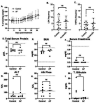This is a preprint.
Auranofin Inhibition of Thioredoxin Reductase Sensitizes Lung Neuroendocrine Tumor Cells (NETs) and Small Cell Lung Cancer (SCLC) Cells to Sorafenib as well as Inhibiting SCLC Xenograft Growth
- PMID: 37215042
- PMCID: PMC10197533
- DOI: 10.1101/2023.05.07.539772
Auranofin Inhibition of Thioredoxin Reductase Sensitizes Lung Neuroendocrine Tumor Cells (NETs) and Small Cell Lung Cancer (SCLC) Cells to Sorafenib as well as Inhibiting SCLC Xenograft Growth
Update in
-
Auranofin inhibition of thioredoxin reductase sensitizes lung neuroendocrine tumor cells (NETs) and small cell lung cancer (SCLC) cells to sorafenib as well as inhibiting SCLC xenograft growth.Cancer Biol Ther. 2024 Dec 31;25(1):2382524. doi: 10.1080/15384047.2024.2382524. Epub 2024 Jul 25. Cancer Biol Ther. 2024. PMID: 39054566 Free PMC article.
Abstract
Thioredoxin Reductase (TrxR) is a key enzyme in hydroperoxide detoxification through peroxiredoxin enzymes and in thiol-mediated redox regulation of cell signaling. Because cancer cells produce increased steady-state levels of reactive oxygen species (ROS; i.e., superoxide and hydrogen peroxide), TrxR is currently being targeted in clinical trials using the anti-rheumatic drug, auranofin (AF). AF treatment decreased TrxR activity and clonogenic survival in small cell lung cancer (SCLC) cell lines (DMS273 and DMS53) as well as the lung atypical (neuroendocrine tumor) NET cell line H727. AF treatment also significantly sensitized DMS273 and H727 cell lines in vitro to sorafenib, a multi-kinase inhibitor that was shown to decrease intracellular glutathione. The pharmacokinetic and pharmacodynamic properties of AF treatment in a mouse SCLC xenograft model was examined to maximize inhibition of TrxR activity without causing toxicity. AF was administered intraperitoneally at 2 mg/kg or 4 mg/kg (IP) once (QD) or twice daily (BID) for 1 to 5 days in mice with DMS273 xenografts. Plasma levels of AF were 10-20 μM (determined by mass spectrometry of gold) and the optimal inhibition of TrxR (50 %) was obtained at 4 mg/kg once daily, with no effect on glutathione peroxidase 1 activity. When this daily AF treatment was extended for 14 days a significant prolongation of median survival from 19 to 23 days (p=0.04, N=30 controls, 28 AF) was observed without causing changes in animal bodyweight, CBCs, bone marrow toxicity, blood urea nitrogen, or creatinine. These results show that AF is an effective inhibitor of TrxR both in vitro and in vivo in SCLC, capable of sensitizing NETs and SCLC to sorafenib, and supports the hypothesis that AF could be used as an adjuvant therapy with agents known to induce disruptions in thiol metabolism to enhance therapeutic efficacy.
Figures





References
Publication types
Grants and funding
LinkOut - more resources
Full Text Sources
